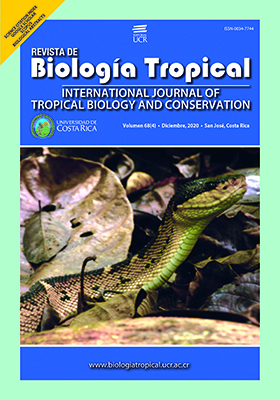Abstract
Introduction: The integument of terrestrial mollusks is highly susceptible to dehydration; therefore, microhabitat selection, seasonality and behavior around the day are crucial to their survival. However, they are still poorly understood, especially for tropical montane wet forest species. Objetive: To analyze activity patterns and microhabitat selection on shrubs of the land snail Tikoconus costarricanus, according to season, daytime and weather. Methods: I conducted the study near “El llano” water dam in a tropical montane wet forest in Costa Rica. I observed daily activity of T. costarricanus, during the rainy and the dry season on a 2 km long trail. I observed 167 specimens and made 781 observations in total. I took note of: season, time, activity, weather, temperature and relative humidity inside the forest, and part of the leaf and height where snails were. Active snails had optical tentacles extended. I analysed daily rainfall data from a nearby meteorological station. Results: This species can be found mainly on understory leaves between 1.1 and 2 m above the floor. They are active the day around during the whole year. Only 24 % of the snails were on the upper side of leaves, but 92 % of them were active. The following behaviors were season dependent: activity peaks, leaf side selection according to daytime and weather, quantity of snails aestivating and vertical distribution. During the dry season, I found more active snails in rainy and cloudy days. During the rainy season I found more active snails in sunny days. During rainy season light hours, active snail percentage on the upper side of leaves decreased with rainfall increase, while in the dry season decreased with temperature increase and relative humidity decrease. During night hours of both seasons, the number of snails on the upper side of leaves decreased considerably in relation to active snails, especially in the rainy season. This snail aestivated on the underside of leaves during periods shorter than 21 h, mainly around noon and afternoons during the dry season. High humidity in this forest allowed snail activity around the day at any season. However, this species aestivated when moisture reached the lowest values, mainly, around noon and in the afternoons in the dry season. The rainfall pattern during the rainy season light hours explains the specimen decrease on the upper side of leaves, but in the dry season it is better explained by the temperature increase and the decrease in relative humidity. During dark hours, the almost complete snail absence on the upper side of leaves during the rainy season is explained if the effect of canopy drip produced by rain and dew condensed on leaves is added to the rain pattern. The situation is slightly different in dark hours of the dry season, in this case, snail decrease on the upper side of leaves is explained by canopy drip from dew and fog precipitation. Seasonal difference in vertical distribution may be a way to avoid rain and rain splash out on the soil. Conclusions: Moisture, temperature, rain, and canopy drip from dew, fog and rain, affect behavior and substrate selection of small terrestrial mollusks that inhabit shrubs in wet tropical rainforests.
##plugins.facebook.comentarios##

This work is licensed under a Creative Commons Attribution 4.0 International License.
Copyright (c) 2020 Zaidett Barrientos


